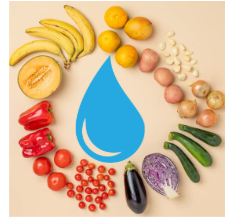Introduction
Every meal we enjoy carries an invisible yet critical ingredient—water. Beyond calories and nutrition, each food item has a hidden environmental cost that is often overlooked. As global concerns over water scarcity, climate change, and environmental degradation grow, understanding the water footprint of what we eat becomes essential for building a sustainable and responsible food system.
The term water footprint refers to the total volume of freshwater used throughout the lifecycle of a food product—from cultivation and processing to packaging and transportation. By uncovering the water demands behind common foods, both consumers and policymakers can make better choices to preserve precious freshwater resources.
What Is a Water Footprint?
The water footprint of a food item is typically expressed in liters per kilogram (L/kg) and includes three main components:
- Green Water: Rainwater absorbed by soil and used by crops.
- Blue Water: Irrigated surface and groundwater applied to fields.
- Grey Water: The volume of freshwater required to dilute and assimilate pollutants generated during production.
Foods with high water footprints tend to exert greater environmental pressure, especially in regions already facing water stress
How Much Water Do Common Foods Consume?
Here’s an overview of the average global water footprints of everyday food items:
| Food Item | Water Footprint (L/kg) | Water Type Contribution |
|---|---|---|
| Beef | 15,400 | Mostly blue and green |
| Pork | 6,000 | Blue and green |
| Chicken | 4,300 | Blue and green |
| Eggs | 3,300 | Green and grey |
| Milk | 1,000 | Predominantly green |
| Cheese | 5,000 | High input from dairy feed |
| Rice | 2,500 | Notable blue water usage |
| Wheat | 1,800 | Mostly green |
| Maize (corn) | 900 | Green water |
| Potatoes | 290 | Very low water demand |
| Apples | 820 | Seasonal green water usage |
| Bananas | 790 | Primarily green water |
| Tomatoes | 180 | One of the lowest water needs |
💡 Note: These are global averages and can vary based on location, farming method, and climate conditions.
Animal vs. Plant-Based Foods: A Clear Divide
Generally speaking, animal products need a lot of water than plant-based diets. This is due to the cumulative water required to grow animal feed, maintain livestock, and process animal products. For instance:
- Producing 1 kg of beef uses around 15,400 liters of water—mostly to grow grains like soy and corn for cattle feed.
- On the other hand, vegetables are much more water-efficient because they typically require only 300 to 500 liters per kilogram.
This stark contrast is one of the reasons why plant-based diets are increasingly recommended for environmental sustainability, especially in water-scarce areas.
The Hidden Cost of Processed and Luxury Foods
Certain processed foods and beverages also carry surprisingly high water footprints:
| Processed Item | Water Footprint |
|---|---|
| Chocolate | ~17,000 L/kg |
| Coffee (roasted) | ~21,000 L/kg |
| Sugar (refined) | ~1,500 L/kg |
| Wine | ~960 L/Liter |
| Beer | ~300 L/Liter |
Though often consumed in smaller quantities, their intensive production processes place a heavy burden on water systems, particularly in countries where these goods are major exports.
Regional Disparities and Ethical Concerns
Water footprints also raise questions of fairness and environmental justice. Many high-demand, water-intensive crops—like avocados from Chile or almonds from California—are produced in areas already facing water shortages. Export-driven agriculture can deplete local water supplies, leaving communities vulnerable and ecosystems damaged.
This makes mindful consumption not just an ecological matter but also a social and ethical responsibility.
How to Reduce Your Dietary Water Footprint
Reducing your water footprint doesn’t mean giving up your favorite foods. It means making informed and sustainable choices. Here are some tips:
- Cut Down on Red Meat
Swapping beef for legumes or poultry can drastically reduce your water use. - Reduce Food Waste
The water used to produce food is likewise wasted when it is thrown away. - Buy Seasonal and Local
Local, in-season produce often requires less irrigation and transportation. - Choose Water-Smart Staples
In general, foods like potatoes, lentils, and cereals use less water. - Be Mindful of Indulgences
Enjoy items like chocolate, coffee, and wine in moderation due to their high hidden water costs.
Innovation and Policy: Charting a Sustainable Future
Governments, researchers, and the agri-food industry are pursuing multiple avenues to minimize water use:
- Water efficiency can be increased by drip and precision irrigation.
- Drought-resistant crop varieties to improve resilience
- Water pricing reforms and sustainable subsidies to encourage better practices
- Food labeling initiatives to inform consumers of a product’s water footprint
Advanced technologies such as remote sensing, satellite monitoring, and AI-driven irrigation systems are also helping farmers conserve water more effectively than ever before.
Conclusion
Water is a finite resource, and its role in our food systems is more critical than ever. By looking at the water footprint of common foods, we gain deeper insight into the true environmental cost of our consumption patterns.
While individual changes—like eating less meat or reducing food waste—do make a difference, long-term sustainability will require systemic action in agriculture, technology, policy, and consumer behavior. In the face of climate change and growing global demand, making water-wise dietary choices is no longer just environmentally conscious—it’s a necessity for a secure, equitable, and sustainable future.
